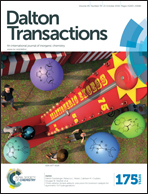Potential applications of polyoxometalates for the discrimination of human papillomavirus in different subtypes†
Abstract
The binding-induced luminescence enhancement of an Eu-containing polyoxometalate (POM), EuSiWMo, by the arginin/lysine-rich cationic peptides supplied a platform to detect the capsid proteins of human papillomaviruses (HPVs). However, the strong binding affinity between them makes it very difficult to be differentiated among peptides from different subtypes of HPVs. Therefore, several strategies to monitor the binding affinity of POM-peptide are performed and finally the discriminations on representative peptides from different subtypes of HPV capsid proteins are achieved in the present study. The results show that an Eu-containing POM, EuW10, with nine negative charges is sufficient to discriminate different subtypes of HPV peptides based on the specific sequence and basic charge differences. The discrimination mechanisms between them explored at sub-molecular level using time-resolved fluorescence spectra and isotherm titration calorimetric (ITC) reveal both the driving force and binding model accordingly. Therefore, this study reports a simple, low-cost and efficient fluorescence enhanced method to discriminate the peptides from different subtypes of HPV capsid proteins, which would be possible after further optimization.


 Please wait while we load your content...
Please wait while we load your content...